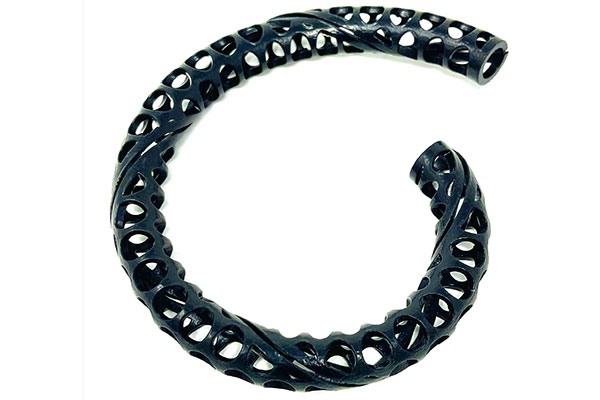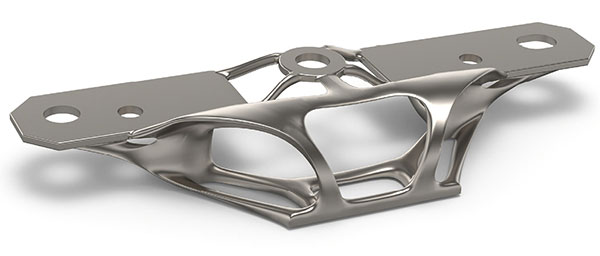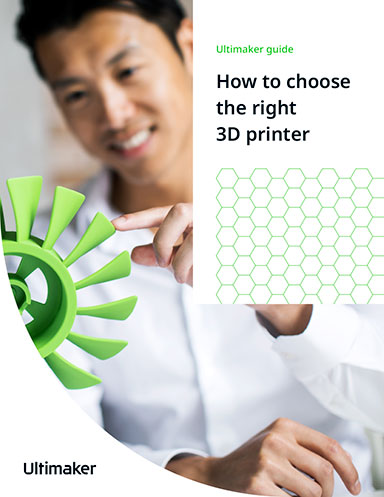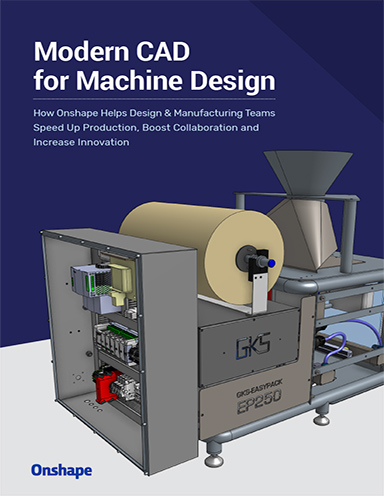Automotive Companies Steer Toward DfAM
Up and down the automotive supply chain, engineering organizations are turning to AM and DfAM principles to gain an edge on electrification and lightweighting design goals.

With HP’s Multi Jet Fusion technology, Ford Motor Company optimized the weight, material and design of its dual-rate chassis coil spring sleeve as an aftermarket part. Image courtesy of HP.
Latest News
April 19, 2022
Lightweighting and electrification—the two major objectives for modern-day vehicle design—are rapidly advancing through more liberal use of 3D printing technologies buoyed by adoption of design for additive manufacturing (DfAM) principles.
Automotive manufacturers and their supplier networks are accelerating the transition to a new generation of lighter weight and battery-powered vehicles to meet increasing consumer demand and in support of more stringent climate policies.
A report by research firm BloombergNEF, projects global sales of electric passenger vehicles (EVs) to surpass 10.5 million this year, about 4 million above 2021 levels. The same report is projecting a 75% increase in zero-emissions commercial electric delivery vans and trucks in 2022. EVAdoption is estimating that EV sales should grow to encompass approximately 29.5% of all new car sales in 2030, up from roughly 3.4% in 2021.
Lightweighting has been a core design goal in the automotive sector for more than a decade as auto original equipment manufacturers (OEMs) strive to improve fuel economy of traditional internal combustion engines to meet increased demand among consumers for reduced fuel costs and to remain in compliance with evolving government regulations. Weight reduction goals have taken on more significance lately as engineering teams look for opportunities to shed pounds across the entire vehicle structure to accommodate the extra mass of battery packs fueling this in-coming generation of hybrid and fully electric vehicles.
Not only must automotive engineering teams zero in on fresh lightweighting opportunities in this new era of design, they must also do so fast to achieve first-to-market advantage. That’s where the push toward 3D printing and DfAM principles comes into play as the sector looks to new production methods that can deliver the agility and design freedom to empower a new generation of vehicle designs.
“Demand for customers and the shift internally to ramp up product development elements and go-to-market capabilities has hugely changed in the past few years,” says Fadi Abro, director of automotive business for Stratasys, explaining that development cycles for a complete clean sheet vehicle from start to finish has shrunk from the conventional 10-year cycle to around 2 to 3 years.
“That time frame fits better with additive manufacturing (AM) because you have to prototype faster, make tooling faster and better, and the production component has to happen faster,” Abro says. “That’s what more of our OEM customers are doing.”
AM and DfAM techniques also address another major trend impacting automotive design—increased demand for customization. More expensive luxury cars and a new crop of EVs and semi- and autonomous vehicles are incorporating all kinds of new gadgets and gear, from customized trim and massaging seats on high-end models to car kits to support outdoor activities, each with different and specialized production needs.
“Because there are more diverse and customized vehicles, it makes less sense to tool up a product and more sense to look at AM as a solution,” Abro says. “AM delivers unlimited customization capabilities.”
AM Won’t Work Without DfAM
AM offers limitless possibilities to output complex lattice structures for building lightweight, high-strength parts and new, organic shapes that consolidate previously separate components. Yet those design wins aren’t possible without embracing an entirely new DfAM mentality—one that veers from conventional rules about what constitutes manufacturability for traditional processes such as casting, computer-numerically controlled milling or injection molding, to one that embraces design freedom with a focus on lightweighting, organic structures and parts consolidation.
“Designing a part has always had to stay within the constraints of the production technology used to produce it and that is limiting,” says Aaron DeLong, a solutions architect with HP. “DfAM is really about optimal part function. It’s that old adage that we’re going to 3D print an injection-molded part, but if it’s stuck in the paradigm of traditional manufacturing, you’ll get what you’ve always gotten—a 3D-printed part designed for injection molding.”
Of course, not every part is a natural fit for AM and DfAM practices. The best candidates are components where complexity is high and volume is low. For example, using DfAM to redesign an air duct along the lines of a complex organic shape that incorporates attachment clips as part of the main design is a perfect use case. In comparison, button covers for a simple hole on a dashboard isn’t a strong candidate for DfAM optimization, instead lending itself to traditional injection-molded design tactics.
At BMW, a roof bracket for the 2018 BMW i8 Roadster was a much heralded, early example of DfAM helping to generate a 3D-printed production part. The component, designed with Altair topology optimization software, was produced with selective laser melting technology with the need of support structures and marked the first time a metal 3D printed part was used in a series production vehicle.

The newly designed part, winner of Altair’s Enlighten Award in 2018, captured 44% weight savings and increased stiffness 10-fold. In automotive application terms, it’s considered a relatively low-volume part.
“Today, volume is the biggest problem in AM—it can meet demands in the hundreds or thousands, but when you go into the millions it’s a challenge, from the costs associated with it to the consistency of properties,” says Ravi Kunju, senior vice president of strategy at Altair.
Volkswagen is also pressing ahead with 3D printing and DfAM for vehicle production parts. Through a collaboration with HP and Siemens Digital Industries Software, Volkswagen is leveraging HP Metal Jet binder jetting 3D printers and DfAM software and methodologies to produce components for the A pillar of the T-Roc convertible. The DfAM designed and 3D printed components weigh almost half of the conventional sheet steel parts; the structural parts have passed crash test certification, and Volkswagen is aiming to produce up to 100,000 parts via 3D printing each year by 2025.
HP and Siemens also teamed up to showcase what’s possible using DfAM principles for part consolidation. A duct assembly that was historically six individual injection molded parts was redesigned using topology optimization capabilities in Siemens NX and Star CCM+ resulting in the “Mighty Duct” part. Produced with HP Multi Jet Fusion printers, the newly designed duct part achieved 22% flow increase to the system and 34.3% cost reduction, according to officials.
In another HP example, Ford Motor Company developed a dual-rate chassis coil spring sleeve as an aftermarket part that had previously been made through extrusion forming. Leveraging HP’s Multi Jet Fusion 3D printing technology and thermoplastic polyurethane, the group was able to optimize the part’s weight and used material, plus simplify assembly by eliminating adhesive between the sleeve and the spring that had been required in the previous design.
Beyond the AM printers, generative design software, topology optimization and DfAM practices are essential to driving these new organic shapes and lightweight designs.
“DfAM without software is not realistic,” says Todd McDevitt, group product manager at nTopology. “You need to be able to visualize the design, check for clearances and validate with simulation that it’s going to work.”
McDevitt adds generative design software also takes DfAM further than what’s possible in traditional CAD. For example, while possible to specify wall thickness in a CAD system to reduce weight, that thickness remains consistent so engineers gravitate to a conservative approach to ensure structural integrity. With DfAM and implicit modeling tools like the nTopology platform, engineers have more flexibility in how to spec and manufacture wall thickness.
“The ability to parameterize and vary wall thickness accordingly based on simulation results is powerful,” McDevitt says.
Rising to the Challenge
Training engineering teams in DfAM principles is a requisite, but investing in the right generative design, topology optimization and simulation software can provide a real jumpstart to change engineering mindsets and encourage experimentation beyond traditional practices. At Altair, design and simulation platforms such as OptiStruct are being updated to support DfAM just as they are grounded in traditional design for manufacturing (DFM) principles.
“We’re closely working with printer manufacturers to understand what the issues are and to figure out the best constraints and move the software in that direction,” says Kunju. “A designer needs to understand volume, costs and materials—all of those parameters dictate which direction a design will go. We build all of that into the software whether that’s for casting, sheet metal forming or AM.”
Multiphysics simulation software can advance DfAM principles beyond lightweighting structural parts to optimizing function and weight for components like heat sinks, cold plates and components of car sound systems.
For example, recently released optimization features in COMSOL Multiphysics enable multiphysics analysis to be incorporated into AM optimization studies, limited only by the creativity of the engineering team and AM processes available, says Bjorn Sjodin, vice president of product management at COMSOL.
In addition, organizations are creating COMSOL Apps from Multiphysics models with specialized user interfaces that have predefined inputs and outputs; this allows design engineers to study and optimize component designs for DfAM principles before producing the final specification for the additive manufacturing process.

The Manufacturing Technology Centre (MTC), independent research and technology organization with a center focused on AM, has created a COMSOL app to help its customers easily apply DfAM principles to the design of parts using laser powder bed fusion AM technology.
With this technology, deformation can be a problem—quick cooling can cause residual stresses during deposition, altering the microstructure and potentially causing distortions in the final part, according to Willem Denmark, technology manager, physics modeling at MTC.
The COMSOL app, which predicts such distortions, helps the design for AM team run simulations to determine where designs need to be changed without having to have a complete understanding of the entire Multiphysics simulation model. While the App approach to DfAM has initially been used for clients in the aerospace sector, it also has applicability in the automotive sector.
Perhaps the biggest impediment to DfAM success is lack of familiarity with AM technology and the new concepts underpinning design freedom. That lack of knowledge is exacerbated by engineering cultures that remain resistant to change.
“Understanding how to design for technology is starting to be more common, but there’s an education gap in the industry,” says Steven Goguelin, R&D engineer at Gen3D, which markets Sulis design software for AM. “Our software allows people to optimize their geometry for manufacturability for AM … and that helps shift the mentality of designers into an AM mindset throughout the entire design process.”
More Altair Coverage
More COMSOL Coverage
More Hewlett Packard Coverage
Subscribe to our FREE magazine, FREE email newsletters or both!
Latest News
About the Author
Beth Stackpole is a contributing editor to Digital Engineering. Send e-mail about this article to [email protected].
Follow DE





